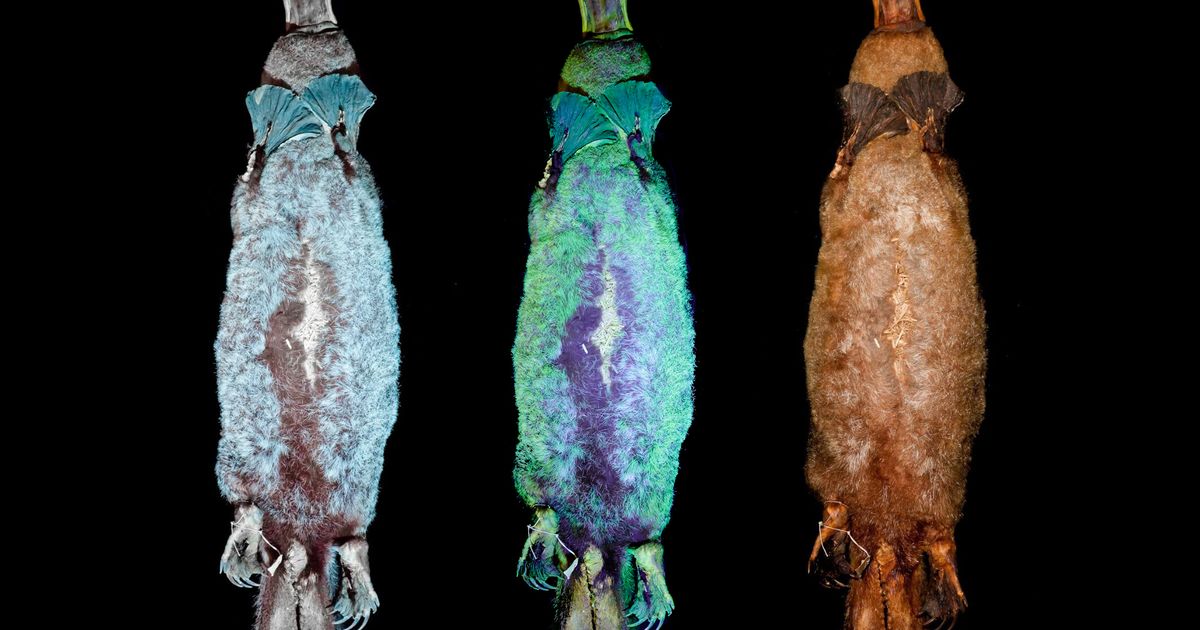
Olson and his team have been leading the recent resurgence into mammalian biofluorescence. Martin, Northland College from Anich et al. “Now I can order one to show up on my doorstep within a few days.” Platypus specimens under UV light. “It is likely because our understanding of how different species interact with different wavelengths of light has only grown over time, and because hand-held UV lights were not that common or accessible a few decades ago,” says Erik Olson, a scientist at Northland College. But the phenomenon remained little-known and under-studied, even amongst serious naturalists, until the past few years. In the 1950s, scientists noticed that their lab rats glowed, while still more research from the 1970s and 80s documented biofluorescence in tree kangaroos and New World marsupial opossums. Reinhold says that the first known report of mammalian biofluorescence dates to the 1940s, when an Australian scientist published an observation that brush-tailed possums glowed under UV light in the final days of World War II, writing that the phenomenon was “not uncommon in mammalian hair.” Then she dove into the scientific literature. She found and photographed both bandicoots and platypus fluorescing under UV light. © Linda ReinholdĪfter discovering the glowing antechinus - and confirming that she wasn’t on an accidental ‘shroom trip - Reinhold spent three days driving around the Far North Queensland forests looking for roadkill.

© Stan Lupo / Flickr 5 of 5Biofluorescence in a close-up of bandicoot fur under UV light. © Stanley Aryanto/TNC Photo Contest 2019 4 of 5Structural color creates the metallic, changeable coloration of a common grackle’s feathers. © Oliver Ruhm / 3 of 5Bioluminescence offshore of Tasmania. © David Souerwine/TNC Photo Contest 2019Ģ of 5Chromatophores help chameleons change their color in an instant. Īnd, as scientists are now learning, biofluorescence is more common in mammals than we realized.ġ of 5Flamingos get their vivid color from carotenoid pigments in their diet. Puffin beaks glow pink and white under UV light, and so do owl wings and budgerigar facial feathers. Biofluorescence is common in invertebrates, reptiles, amphibians, fish, and even birds.

PLATYPUS BLACK LIGHT SKIN
Biofluorescent animals have fur or skin that absorbs short-wavelength light (ultraviolet) and re-emits it as longer wavelength (in the visible spectrum) that humans can see. These creatures often have a metallic or iridescent sheen, like blue-green beetles or the purple-green shimmer of a grackle’s wing.īioluminescent animals - like glow worms, anglerfish, or phytoplankton - or produce their own light through a chemical reaction within their bodies. Other animals - like chameleons, octopus, or cuttlefish - can change their color using pigment-containing cells called chromatophores.Ĭritters with structural color have feathers or a carapace covered in microscopic structures that reflect light. Flamingos and house finches get their red coloration from the shrimp or plants they eat, which contain carotenoid pigments that accumulate in the birds’ feathers. Other animals derive their color from pigments in their diet. Melanins are one of the more common pigments, which is why so many mammals are various shades of brown. Many animals, including humans, derive their color from pigments in their skin or hair.

PLATYPUS BLACK LIGHT FULL
The animal world is full of color, but these hues are created with very different mechanisms. A southern flying squirrel under UV light. Scientists are discovering dozens of mammals that glow under ultraviolet light, from flying squirrels to wombats to African springhares. “I thought there was an 80 percent chance I was hallucinating.” “Just a few minutes earlier I’d found the biggest bunch of ghost mushrooms I’d ever seen, so when I saw the fluorescent mammals I wondered if I’d accidentally licked my fingers or put my hands in my mouth,” she said. But when she switched to her UV light, the antechinus glowed bright white, like a fuzzy glowstick. Under normal light, its fur was a soft brown. Linda Reinhold was hiking through the Australian rainforest in search of mushrooms when she saw something small and glowing dash through the beam of her UV flashlight.Īnother one skittered forward, pausing long enough for Reinhold to identify it as an antechinus, a mouse-like marsupial.


 0 kommentar(er)
0 kommentar(er)
